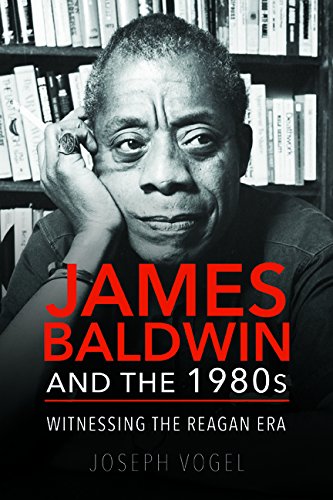The Book
James Baldwin and the 1980s: Witnessing the Reagan Era, Urbana: University of Illinois Press, 2018.
The Author(s)
Joseph Vogel

Reading and discussing James Baldwin is once again in vogue. Important American writers such as Toni Morrison and Ta-Nehisi Coates have cited him as a critical influence on their own crucial voices in modern American letters. Most activists—especially, but not only, those tied to the Black Lives Matter movement—have at least some passing familiarity with Baldwin’s legendary essays. Critically acclaimed documentaries (I Am Not Your Negro) and films (If Beale Street Could Talk) both draw from the works of Baldwin. Yet, much of the work we associate with Baldwin does not include his plethora of writings from the 1980s that dealt with the rise of Ronald Reagan and culture war politics in the 1980s. Joseph Vogel’s James Baldwin and the 1980s seeks to correct that missing element of modern Baldwin studies.
For Vogel, the Baldwin of the 1980s is just as important to the author’s story as the rest of his work. His work in the 1980s shows that Baldwin was still “one of the most prescient observers of the post-civil rights landscape,” according to Vogel. (2) The book’s scope of the final decade of Baldwin’s life shows how the author engaged with a variety of Reagan America-era concerns: gender and sexual identity, culture and politics, the AIDS epidemic, and the rise of a “New” South centered around the Black political and economic engine of Atlanta. The “renaissance” in Baldwin studies, as Vogel calls it, depends on scholars taking a stronger look at the James Baldwin closer to the end of his life, wrestling with both a rapidly changing American society, and with some of the older problems (such as racism) Baldwin always wrote about, but which were now changing form.
Some of the sharpest parts of James Baldwin and the 1980s deal with the intersection of African American music and the cultural history of the decade. Vogel spends two chapters interpreting Baldwin’s works on African American music and culture—chapter one focusing on Baldwin’s final novel, Just Above My Head (1979), and a landmark Baldwin essay, “Freaks and the American Ideal of Manhood,” in chapter two. There is a great deal of rich content which Vogel highlights, but what makes his book particularly useful to intellectual historians of the recent past is the ease with which he weaves together cultural theory, popular culture, and recent history. To Vogel, this was a necessary part of working on Baldwin, considering that Baldwin himself often did the same. Baldwin no doubt understood—as historians such as Charles Hughes have noted—that African American music in the 1960s and 1970s occupied a liminal space in American culture and thought: being both “commercially popular and culturally influential, yet simultaneously marginalized and critically devalued.” (31) For Baldwin, understanding African American popular music, along with popular culture more broadly, as a critical part of his writing in the 1970s and 1980s.
Much of Vogel’s work also approaches how Baldwin wrestled with his identity as a Black, gay man in an era when both were still seen as less than fully human. Baldwin, in Vogel’s estimation, did not shy away from being gay in public—but for Baldwin, sexual identity was far more complicated than being “gay” or “straight.” This partly explains Baldwin’s interest in sexually androgynous figures in the 1980s as Michael Jackson or Prince, two superstar musicians who challenged ideas of masculinity and—for some critics within the African American community—specific notions of Black manhood. Baldwin’s examinations of these and other figures in essays such as “Freaks and the American Ideal of Manhood” (published in Playboy in 1985) will likely become more important as the debate over Black identity in the United States is complicated by the growing voice of gay, lesbian, and transgender activists within the African American community pushing back against racism and anti-LGBTQ ideology.
Vogel’s final chapters paint a picture of Baldwin struggling to come to terms with three major themes of the 1980s: the AIDS crisis, the rise of the Religious Right, and Atlanta’s place as capital of the New South. In a way, they were all themes Baldwin had dealt with before in his writings about the “other,” religion, and the South during the Civil Rights Movement. Vogel’s rich and in-depth study of the unpublished Baldwin play The Welcome Table, still being worked on when Baldwin died in 1987, is an integral part of the book and a reminder of just how much unpublished works in progress offer unique ways at seeing how public figures thought about the world around them. The work that Vogel has done in James Baldwin and the 1980s is reminiscent of recent scholarship on the later decades of W.E.B Du Bois, or the resuscitation of Lorraine Hansberry’s career beyond A Raisin in the Sun. James Baldwin and the 1980s is a stand-out in recent African American history and literary studies, certainly worth the time of anyone interested in Baldwin or modern America.
About the Reviewer
Robert Greene II is book review editor for the Society of U.S. Intellectual Historians. He is also Visiting Assistant Professor of History at Claflin University, a Ph.D. Candidate in History at the University of South Carolina, and has been published at The Nation, Jacobin, Scalawag, Dissent, and Black Perspectives, among other places.

0